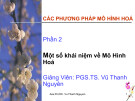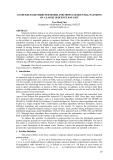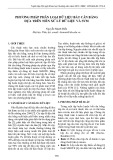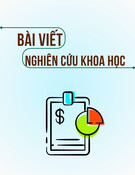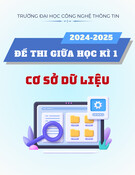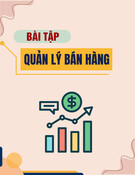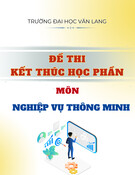
A new approach for data clustering based on granular compung*Truong Quoc Hung, Nguyen Huy Liem, Vu Minh Hoang, Tran Thi Hai Anh and Nguyen Thi LanInstute of Simulaon Technology, Le Quy Don University, VietnamABSTRACTThis paper introduces a new clustering technique based on granular compung. In tradional clustering algorithms, the integraon of the high shaping capability of the exisng datasets becomes fussy which in turn results in inferior funconing. Furthermore, the laid-out technique will be able to avoid these challenges through the use of granular compung to bring in a more accurate and prompt clustering process. The creaon of a novel algorithm hinges on ulizing granules, which are the informaon chunks that reveal a natural structure as part of the data and also help with natural clustering. A tesng of the algorithm's features is carried out by using state-of-the-art datasets and then an algorithm's effecveness is compared to the other clustering methods. The results of the experiment show significant improvement in clustering accuracy and reducon in data analysis me, thus tesfying how granular compung is efficient in data analysis. This quest is not only going to serve as a reinforcement in data clustering, but it will also probably be an input in the broader area of unsupervised learning, reinforcing posions for scalable and interpretable soluons for data-driven decision-making.Keywords: data clustering, clustering of informaon, granular Compung, informaon granule, unsupervised learning, accuracy of the algorithmFuzzy clustering algorithms were developed to handle uncertain or imprecise informaon. The Fuzzy Possibilisc C-means (FPCM) method can be ulized to idenfy outliers or eliminate noise [1]. However, clustering problems oen involve large and high-dimensional datasets, which present challenges in extracng useful informaon from these datasets [2]. Most clustering algorithms, including the FPCM algorithm, are generally sensive to large amounts of data.Data clustering is one of the major areas that has gained a lot because of the huge progress being noced in the areas of granular compung, whereby granular compung is the current froner in clustering development [3]. A concept of segmental compung, where informaon blocks in its structure give a different paradigm for structuring and analyzing data as compared to the tradional one. The exisng research, as the systemac studies so to speak, has developed a vast background for microorganisms and has been helpful for different types of tasks. In addion, the complicated es arising from the limitaons of the conducted research which are, first, the indefinite nature of scalability, and secondly, the uncertainty towards the final results have been revealed; however, the proposed study is purposed to address all these.Many heurisc algorithms deal with high-dimensional datasets by removing noise and redundant features (also known as feature selecon). However, these algorithms need labeled samples as training samples to select the necessary features. Therefore, they are not suitable for clustering problems. Granular compung (GrC) is a general computaon theory for effecvely using granules (such as classes, clusters, subsets, groups, and intervals) to construct an efficient computaonal model for complex applicaons with vast amounts of data, 75Hong Bang Internaonal University Journal of ScienceISSN: 2615 - 9686 DOI: hps://doi.org/10.59294/HIUJS.VOL.6.2024.632Hong Bang Internaonal University Journal of Science - Vol.6 - 6/2024: 75-82Corresponding author: Dr. Truong Quoc HungEmail: truongqhung@gmail.com1. INTRODUCTION

76Hong Bang Internaonal University Journal of ScienceISSN: 2615 - 9686Hong Bang Internaonal University Journal of Science - Vol.6 - 6/2024: 75-82informaon, and knowledge. GrC is also one of the ways to deal with feature selecon problems. In addion, GrC may be used to construct a granular space containing a granule set that is smaller than the original one but connues to represent the original dataset. Thus, the size of the dataset is reduced, so that clustering problems with large and high-dimensional datasets can be solved more effecvely. Therefore, hybrid models between GrC and fuzzy clustering can improve the clustering results [4-6]. Recently, the idea of granular gravitaonal forces (GGF) to group data points into granules and then process clusters on a granular space has been proposed [7, 8]. In this method, the size and noise of the original dataset are reduced, and the inial cluster centroids are determined.Datasets have become both tangled in complexity and massive in size, so the major move for current work is to develop clustering algorithms that can avoid the colossal impact of this. The authors present the new theories and methods that bring rare viewpoints to exisng schemes and which as a result allows one to see more clearly the clustering methods. This is most significant, especially, in big data or machine learning which are where analysis of data and comprehensibility is taken as of the highest priority.The organized outlook of this paper is well-craed as it begins with theorecal foundaons of how granular compung will help you in data clustering (in secon 2). Aer the previous two secons, the method that combines the jusfied granularity principle into a new clustering algorithm is presented and discussed in the implementaon and evaluaon (Secon 3). The next segments will cover all phases of the current experiment and the final outcomes deduced from the research conducted.2. PROBLEM 2.1. Theorecal FoundaonsThe proposal of the clustering method foundaons on granular compung (GC), which tool enables data analysis by creang informaon granules instead of data volumes. GC does its job using data encapsulaon, which helps to decouple the data from the physical form it has and allows operaons on it to be more inexpensive to perform.2.1.1. AssumponThis research is in that granules, movements of natural systems which are apparent on naonal scales but manifest only in the analysis of local data clusters, are sufficient to understand the natural systems in queson. These sphere-shaped kernels are supposed to be achieved with an even granulaon throughout the enre archival data so it can provide a uniform measurement of granularity throughout the dataset.2.1.2. FormulasGranularity Coefficient (GC): The Grain Size Coefficient is a quantave measurement that specifies how varying the granularity is within a dataset. The granularity is computed by dividing the sum of the granules by the data point's total number of data points. Formula: GC = g/n, where g is the number of granules, and n is the number of samples.Bigger GC specificaon shows that data was divided into smaller-grained groups with a higher number of their raons, which also means that clustering was done more accurately. On the contrary, the low GC value is a hint that the distribuon has a wider granularity and a bigger size, which means that the groups are fewer and larger in those clusters [9]. The Granulaon Radius is the area occupied by a granule in the whole set. It indicates the dimension of the granules when the spaal relaonships of the data points are considered as another main factor.a. The process of Generang Granular SpaceSome definions which were proposed in [10], are introduced to granulate the clustering system as follows:Definion 1: Granular Space Compung dGiven dataset X = {x , x Î R }, i = 1, 2, …, n, where n is iithe number of samples on X. The granular space G = {G1, G2, …, G} is used to cover and represent the gdata set X. The G coverage degree is determined asj , where ǀGǀ is the number of samples j in G.j The basic model of granular space coverage can be expressed as:When other factors remain unchanged, the higher the coverage, the less the sample informaon is lost, and the more the number of granules, the characterizaon is more accurate. Therefore, the minimum number of granules should be considered to obtain the maximum coverage degree when generang granules. In most cases, β and β are set 12to 1 by default.(1)

77Hong Bang Internaonal University Journal of ScienceISSN: 2615 - 9686 Hong Bang Internaonal University Journal of Science - Vol.6 - 6/2024: 75-82Definion 2: The Process of Generang Granular Space- For each G , the θ is the center of G and r is the jjjjradius of G . The definions of θ and r are as follows:jjj - Distribuon Measure DM is defined as follows:jwhere is the sum radius in Gj.- We treat the whole dataset as a granular space O. Suppose that O are sub-granules of O and both kDM and DMare smaller than DM then O was O1O2 O1split into O and O. The DM (weighted DM 12Wvalue) can beer adapt to noisy data. It is defined as follows:- Removing granules with a radius that is too large: if r > 2 * max (mean(r), median(r)) then G is split.jjThe Generaon of the Granular-Space algorithm can be briefly described as follows:Algorithm 1 Generaon of Granular-Space.dInput: A dataset X = {x , x Î R}, i = 1, 2, …, n the iinumber of clusters c (1< c < n)Output: The granular space G1- For each granule G in X doj2- Calculate DM, DM by using (1), (2), (3), (4)OW 3- If DM³ DM Then Split GW Oj4- If the number of G not changing Then break; 5- End For6- For each granule G in X doj7- calculate (mean(r), median(r),8- If r³2 * max (mean(r), median(r)) Then Split Gj j9- If the number of G is not changing Then break;10- End For11- Return Gb. Clustering FPCM based on Granular-Space (FPCM-GS).First, execute Algorithm 1 to obtain the granular space G, then apply the Fuzzy Possibilisc C-Means Clustering Algorithm [1] on the granular space G (FPCM-GS).The objecve funcon for FPCM-GS was built as follows:where g is the number of granules on G, c is the number of clusters, d is the distance between the ikcentroid v and the θ which is the center of G; p and ikkm are weighng exponents (possibilisc membership and fuzzifier), is the scale parameter iis determined as follows:t is the possibilisc membership degree and u is the ikikdegree of fuzzy membership. They are computed as follows:The centroids of cluster v are determined in the same iway of FPCM as follows:in which i = 1, 2, …, c; k = 1, 2, …, g.The FPCM-GS algorithm can be briefly described as follows:Algorithm 2 Advanced FPCM based on Granular-Space.dInput: A dataset X = {x , x Î R}, i = 1, 2, …, n, the iinumber of clusters c (1< c < n), error ε.Output: T (the possibilisc membership matrix), U (the fuzzy membership matrix), and V (the centroid matrix).1-Execute Algorithm 1 to obtain the granular space G2- l = O3- Repeat:4- l = l + 1(l)5- UpdateT by using (8)(l)6- Update U by using (9) (l)7- Update V by using (10)8- Apply (7) to compute γ, γ…, γ1 2, c9- Unl: (l +1)(l)10- Max ( ǁU – U ǁ ) ≤ ε11- Return T, U, V 2.2. Experiment PreparaonThe proposed clustering algorithm was experimentally (10)(9)(8)(7)(6)(5)(4)(3)(2)

78Hong Bang Internaonal University Journal of ScienceISSN: 2615 - 9686Hong Bang Internaonal University Journal of Science - Vol.6 - 6/2024: 75-82Table 2. The results of the experiment in terms of indices TPR and FPR
Datasets
Number of samples
Number of clusters
WDBC
569
2
DNA
106
2
Madelon
4400
2
Global Cancer Map
190
14
Colon
62
2
Datasets
FCM
FPCM
FPCM-GS
FPR
TPR
FPR
TPR
FPR
TPR
WDBC
4.5%
89.5%
2.8%
92.7%
1.8%
95.8%
DNA
6.7%
85.6%
3.1%
91.4%
1.7%
96.1%
Madelon
5.9%
86.1%
3.3%
90.8%
2.0%
94.9%
Global Cancer Map
4.8%
89.6%
5.5%
90.2%
1.2%
96.8%
Colon
7.9%
79.1%
9.5%
80.9%
1.6%
92.2%
validated by carefully implemenng and execung a set of experiments that were conducted according to a well-defined set of guidelines.Some well-known available datasets are used in the experiments. We also offer a comparave analysis of the clustering results between some clustering algorithms (FCM, PCM, FPCM) and GrFPCM. Through the process of experiment, the clustering results are stable with parameters: m = p = 2; ε = 0.00001; K = 1.2.2.1. InstrumentaonThe clustering results are evaluated by determining indices: False Posive Rate (FPR) and TPR (True Posive Rate). They are defined as follows:in which:- FP: the number of incorrectly classified data.- TN: the number of correctly misclassified data.- TP: the number of correctly classified data.- FN: the number of incorrectly misclassified data.2.2.2. Experimental MaterialsThe algorithms are implemented in the VC++ program and run on Intel Core i7-3517U CPU 1.90GHz - 2.40GHz, 8.0 GB RAM.3. RESULTS AND DISCUSSION3.1. Input DataThe data that formed the input were a heterogeneous set of mullayered, muldimensional data sets that had different levels of complexity and considerable size. These datasets were retrieved from adequately performing informaon strings and treated to make them consistent and valid for experimentaon.Specifically, in this case, the well-known datasets are WDBC, DNA, Madelon, Global Cancer Map, and Colon are considered. The datasets are shown in Table 1.3.2. Simulaon results and comments3.2.1. Clustering resultsThe results of the experiment are reported in terms of indices TPR and FPR, which are shown in Table 2 and graphically shown in Figures 1 and 2. These results also show the quality of classificaon when performing the clustering by each method. Table 2 shows the results of the clustering, in which the lower the FTR value and the higher the TPR value, the beer the method is. The FPCM-GS algorithm obtained the smallest FPR and the highest TPR on all five datasets.(11)Table 1. Datasets are used to illustrate the proposed method

79Hong Bang Internaonal University Journal of ScienceISSN: 2615 - 9686 Hong Bang Internaonal University Journal of Science - Vol.6 - 6/2024: 75-82Figure 2. The TPR values of clustering resultsFigure 1. The FPR values of clustering resultsFrom the results of the experiment in terms of indices TPR and FPR, the TPR values obtained by running FPCM-GS on five datasets are greater than 92% and obviously higher than the ones obtained from other algorithms. In addion, the FPR values are also smaller than the ones reached by other methods. Therefore, we can conclude that by forming the granular space for experimental datasets, the quality of the clustering results has been improved.The computed results of the analycal techniques demonstrated that the clustering approach of granular compung provided outcomes that were more accurate than the ones of the old-fashioned methods.The findings reveal that the micro-style of

